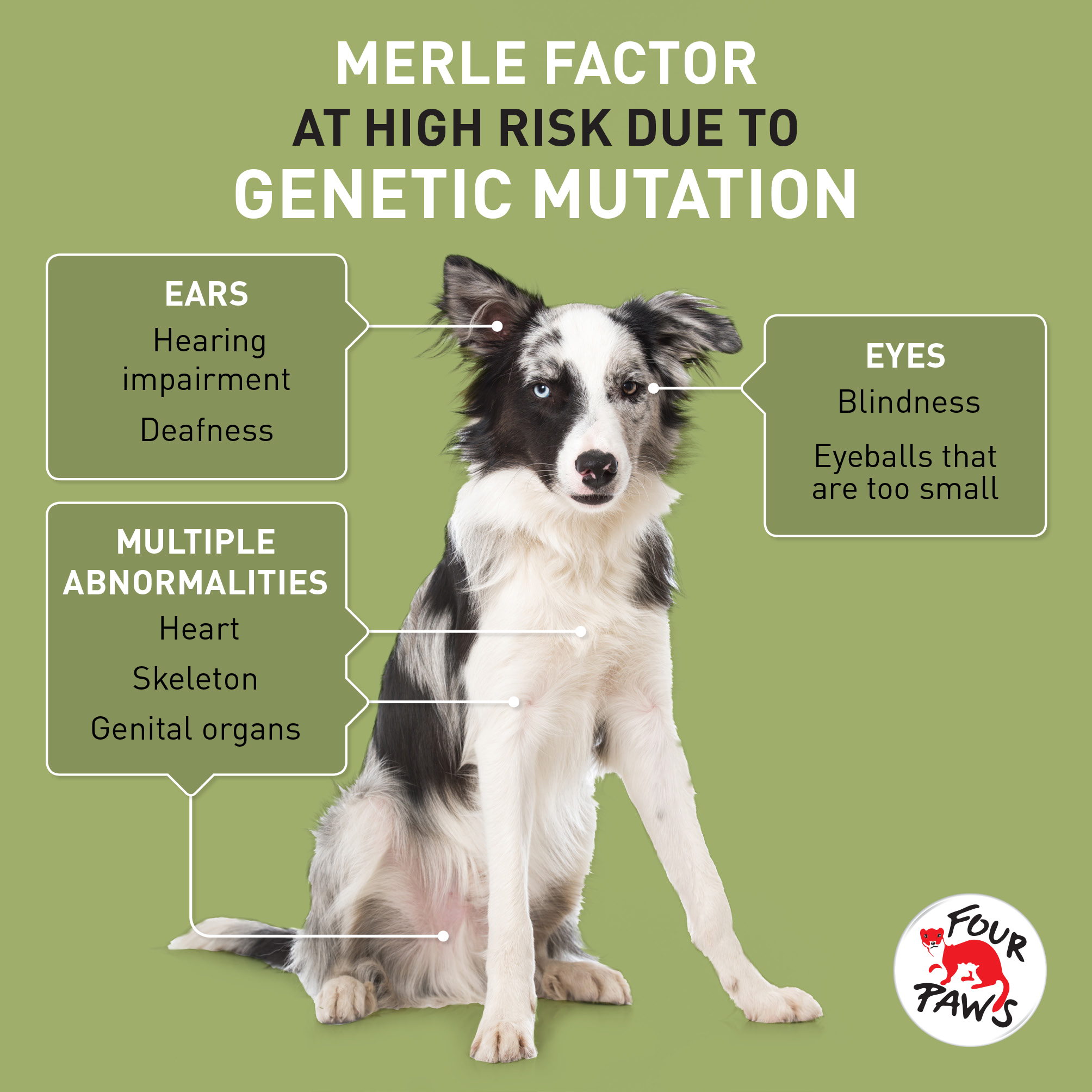
The Suffering of Dogs With Genetic Disorders
A wide variety of genetic disorders are known in dogs, from brachycephaly, heart defects and epilepsy, to blindness and deafness
Genetic disorders can affect all organs and body parts and can lead to conditions that cause pain, such as organ compressions, malformations or deficiencies, all resulting in a life full of suffering.
Some dog breeds are bred to have skin wrinkles. These breeds include the Shar Pei, Saint Bernard and Pugs. Due to these skin folds, all affected breeds are prone to skin inflammation and infections.
For the Cavalier King Charles Spaniel, the small skull size for which they were bred, reduces the space required to fit the entire brain. As a result, the brain is compressed giving rise to two different disorders, Syringomyelia and the Chiari malformation, that have been identified in 97% of these dogs¹. Symptoms include severe headaches, vision problems, balance problems, dizziness and even hearing loss.
The selective breeding for specific fur types can also cause suffering. Long coats, such as the Lhasa Apso has, can become matted and are prone to bacterial infections without regular, meticulous care. Long fur can also impair the dog’s visibility, mobility, thermoregulation and communication. In contrast to long fur, other dog breeds are hairless, such as the Chinese Crested Dog. This breed is susceptible to sunburn and hypothermia/freezing due to a lack of fur.
Genetic disorders are not limited to appearance but encompass also physiological disorders, which affect an animal’s quality of life. Bernese Mountain dogs and Beagles can suffer from epilepsy, Doberman Pinschers can suffer from circulatory disorders, and German Shepherds and Labrador Retrievers can suffer from hip dysplasia.
Of the numerous genetic disorders related to selective breeding, one of the best known is brachycephaly. A somewhat lesser known issue is the breeding of the Merle fur colour and the severe health implications associated with it.
What is 'Brachycephaly'?
'Brachycephaly' describes a condition in which the skull of the animal has been shortened and rounded through selective breeding. In its extreme form, brachycephaly is associated with severe health problems.
The disorders, deviations and impairments associated with brachycephaly are referred to collectively under the term 'brachycephalic obstructive airway syndrome' (BOAS), affecting breeds such as Pug, French and English Bulldog, Shi-Tzu, Pekingese and Boxer. Around 24 dog breeds are affected by BOAS².
What is the impact of brachycephaly on the animal?
The syndrome encompasses anatomical and physiological disorders relative to skull shortening. Narrowed nostrils and small nasal cavities, misshapen nasal conches, a long and thick soft palate, distorted laryngeal and tracheal structures are some of the anatomical features these dogs have with this condition. Collectively, these changes generate brachycephalic obstructive airway syndrome (BOAS). The narrowed nostrils make it difficult to breathe in through the nose. The nasal conches, that normally heat up or cool down inhaled air are dysfunctional and impede both breathing and temperature control. The soft palate is so long that the tip protrudes into the airways and obstructs the air flow to the lungs. In the worst case, animals of the affected breeds struggle with severe breathlessness.
Initially, their breathing is noisy, snoring, whistling, and the animals pant a lot, especially under stress. Dogs more severely affected have significantly more pronounced breathing noises, tire more quickly during physical exertion and, in extreme cases, faint. Sometimes there is coughing, choking and vomiting. Secondary problems can develop over time. This includes inflammation of other parts of the airways and ultimately also heart problems.
Depending on the severity of the symptoms, affected dogs can no longer interact with other dogs, and warm weather becomes a threat due to the body's issue with cooling. Even sleeping becomes torture for the animals, as they often only get air through an open mouth. There are reports of dogs sleeping in a sitting position or using a toy to keep their mouth open so that they can breathe, anything to ensure the mouth does not close when sleeping and they can breathe. In addition to breathing difficulties, digestion problems, malformations of the spine, recurrent ear infections, misaligned teeth, patellar luxation, hip joint problems, cruciate ligament tearing, and herniated intervertebral discs are just a few of the many disorders these breeds suffer from.
Spotted and colourfully patterned – What is Merle?
'Merle' refers to a colour variation and fur pattern in dogs and occurs through a change in the pigmentation gene. The basic colour of an animal’s fur is lightened and grained in places. The eyes of Merle dogs are also unusual: blue, white or blue-white. Typical Merle breeds include the Australian Shepherd, Collie, Chihuahua, Dachshund, Border Collie and Great Dane. The selective breeding for this colour is often accompanied by ocular and auditory defects.
What is the impact of 'Merle' on the animal?
Animals with Merle can struggle with various health problems. Ears and eyes are primarily affected by the genetic mutation. Depending on the extent the affected dogs may experience hearing impairment or even deafness. Typical eye disorders include deformed pupils, eyeballs that are too small, and partial or complete blindness.
In addition to the typical diseases of the ears and eyes, multiple abnormalities of the skeleton, heart or genital organs can also occur. An investigation also showed that Australian Shepherds with Merle colouring have a marked tendency to develop epilepsy. A general increased mortality rate amongst affected puppies was also found
Behaviour seems secondary
Selective breeding is focused primarily on appearance, often disregarding the psychological component, that of personality and behaviour. Selective breading can lead to various behavioural problems, such as anxiety and aggression.
Selecting for morphologic extremes, such as the lack of a tail in English Bulldogs or the exaggerated long ears in Basset Hounds, deprives the animals of the opportunity to express natural behaviours. Tails, ears, facial expressions and raised neck hair are important communication cues for dogs. Appearance of a dog can therefore lead to compromising communication.
Source
2) https://www.hsvma.org/brachycephalic


